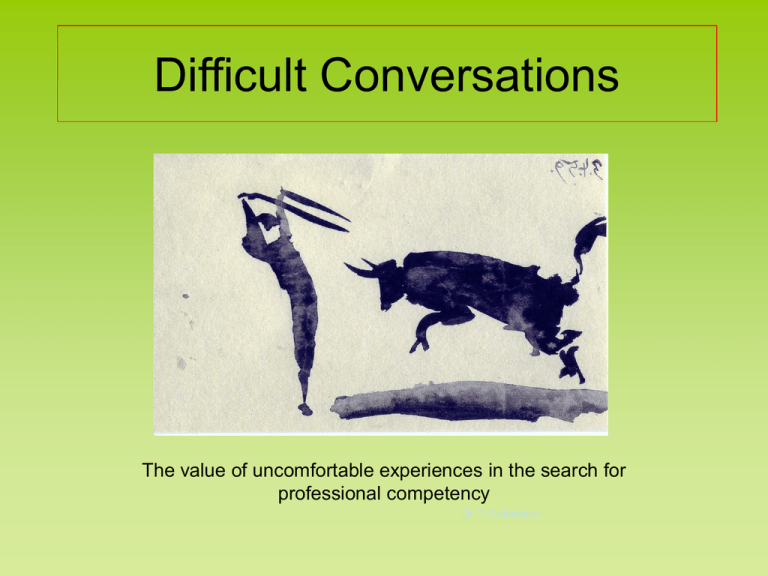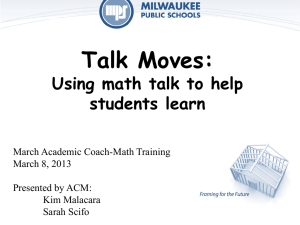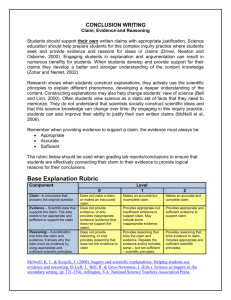Difficult conversations a productive approach
advertisement

Difficult Conversations The value of uncomfortable experiences in the search for professional competency Dr P. Culbertson Difficult conversations a productive approach How to discuss what matters most Based on research by Carol Cardno Practice leading to change Comfort Disequilibrium Threat Critical dialogue = a conversation that is simultaneously critical and collaborative “Every man takes the limits of his own field of vision for the limits of the world” Arthur Schopenhauer (1851) What are the characteristics of a difficult conversation • Defensiveness – – – – – Covering up Bypassing threat Being indirect Giving mixed messages Withholding information Avoidance and control are the two major strategies of defensiveness Reasoning Productive or defensive “Productive reasoning is based on what we call mutuality. Principles of shared control, shared thinking, shared evidence, shared planning for improvement and joint responsibility for monitoring” (Piggot Irvine & Cardno, 2006 ) “Defensive reasoning is the tendency to protect oneself from potential threat or embarrassment. Defensive routines are those behaviors which allow us to cover up or bypass threats” (Ibid) Productive Reasoning Productive reasoning involves a balancing act between the two predominant features of advocacy and inquiry. Advocacy: supporting that position that in such a way that is both hypothetical and invites evaluation and challenge. Inquiry: checking our own and others perceptions in ways which reveal implicit and explicit assumptions Bilaterality (two sidedness): Informed mutual checking of meaning, understanding, perspective, and agreement, is central to the success of the approach. Defensive reasoning Productive reasoning Guiding values: Guiding values: •Seek and give valid information •Share control and solution •Monitor solutions jointly •Win - don’t lose •Avoid unpleasantness' •Maintain control Strategies: •Not checking assumptions •Giving indirect or mixed messages •Not explaining reasoning •Using questioning to control Strategies: •Checking assumptions •being forthright •Disclosing reasoning •asking questions as genuine inquiry The triple I approach Ie 3 Information - focus on giving and getting quality information Disclose your position Illustration - Inquiry explain the basis for making judgment, give examples - ask relevant questions to seek information - ask questions that check your assumptions • Overcoming defensiveness first involves looking at the way that we personally are implicated in the problem Eileen Piggot-Irvine 1995 Expressives Amiable Motivated by recognition Achievement Driver acceptance security Analytical Un-learning “To un-learn defensive approaches you have to become a reflective learner.” “You have to learn how to slow down or stop when you become aware that your normal approach is not producing a desired result.” Cardno Reflective practice Donald Schon Reflective practice is about focusing on action Knowing-in-action Be able to understand and describe what we know we do in a given situation Reflection-on-action Ability to stop, stand back, and think about what has happened Reflection-in-action Ability to think about what we are doing while we are doing it and are capable of changing our actions mid-performance How style impacts on climate Effective leaders develop the capacity to make judgments based on their knowledge of: • Themselves • The situation and the people involved • Each style and its capacity, demands and effects The quality of these judgments is strongly linked to Emotional Intelligence and its three pillars: • Self awareness • Empathy • Understanding of communication and relationship dynamics Learning conversations “In learning conversations people recognise the importance of treating different accounts of a problem as a resource for learning better ways of thinking about or resolving a problem” Its about being open to learning from others and surfacing values, beliefs and assumptions. The drive in a learning conversation is for better quality thinking and reasoning” (Robinson & Lai, 2006) D L D L D L D L Conversation Self/peer critique Well I need to have a little bit of a conversation with you Anne No evidence Ok,Ok, that’s fine Not checking assumptions Yes, I'm afraid that I have to address something with you OK Its just that, well its probably not that big a deal really, but someone has noticed that you are coming really late into school sometimes Oh really? I’m afraid so. I've had a few comments about it from a few people Oh, Ok who? Giving false reassurance to fudge essential message etc…………… Collaboration Difficult conversation Your response Self/peer critique Co construction





